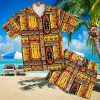Related products
hawaiian
hawaiian
Barber_Neon_Hawaiian_Shirt removebg preview transformed
Around 11 AM, the Barber_Neon_Hawaiian_Shirt removebg preview transformed arrived. Several large, police officers approached us. They told us that they were going to shut down the operation as it was causing a huge traffic jam. I got a brainstorm, I asked the officer that appeared to be in charge if I could have a word with him (Note, I was in my hippie mode at this time). He agreed. I said, “These trees are free to anyone.” He said, “So what” I said “there are free to anyone, including the police department. You could pick up as many of the trees as you want and take them down to Watts (a very poor part of town) and give them away. Think of the PR you could get out of that.” The lights went on in his head and he turn around and talked to the other officers. I do not know what he said, but in a very short time, there were a lot more officers, but they were now directing traffic. Soon a large truck from the police department pulled up and they starting filling the truck with tress. They were already sending in an advance unit to prepare for the Christmas tree give away.
 ()
()Barber_Neon_Hawaiian_Shirt removebg preview transformed,
Best Barber_Neon_Hawaiian_Shirt removebg preview transformed
In Korea, where it’s called Seollal, there’s also a complicated political history behind the Barber_Neon_Hawaiian_Shirt removebg preview transformed. According to UC Davis associate professor of Korean and Japanese history Kyu Hyun Kim, Lunar New Year didn’t become an officially recognized holiday until 1985 despite the fact that many Koreans had traditionally observed it for hundreds of years. Why? Under Japanese imperialist rule from 1895 to 1945, Lunar New Year was deemed a morally and economically wasteful holiday in Korea, Kim said, despite the fact that Lunar New Year has always been one of the country’s biggest holidays for commercial consumption. But Koreans never stopped celebrating Lunar New Year simply because the government didn’t recognize it as a federal holiday, Kim said. So as South Korea shifted from a military dictatorship towards a more democratized society in the 1980s, mounting pressure from the public to have official holidays and relax the country’s tiring work culture led to the holiday being added to the federal calendar as a three-day period.
 ()
()If this question were asked a Barber_Neon_Hawaiian_Shirt removebg preview transformed of weeks later, I’d probably have photos to show. As it stands, you’ll have to put up with my descriptions. We don’t tend to do anything radically different to the rest of the world where Christmas decorations are concerned. Santa’s still wearing a big red suit, there are reindeer, even snowmen and plenty of artificial snow – some of which looks like cobwebs to me, but there you are. We still have Christmas trees covered in tinsel and with stars or angels on the top of them, depending on your preference. I’ve occasionally seen decorations which make a bit of a nod to where we actually are in the world. Santa-on-a-surfboard, kind of an idea. Several years ago, we had a tradition of driving around looking at the Christmas lights other people had put up, and I can definitely recall seeing images of koalas and kangaroos with Santa hats and the like. Overall, though, Christmas decorations tend to look like they’re from the northern hemisphere, since a lot of our “Christmas cues” come from that part of the world, regardless of how warm the day itself may actually be.
- Production Time: All orders are processed within 3 – 4 business days.
- Shipping Time: You will receive your order anywhere from 5 – 10 business days (depending on the shipping method you chose) from the date that it is shipped out, not the date the order is placed.
- Return & Exchange: A full-refund of your purchase! Absolutely risk-free, no question asked. In case of defective or damaged goods, we will send a replacement to you (No any extra fee) within 30 days since your purchase.
- Tracking Number: When available, we will send you the tracking number with the confirmation email so that you can track the package online.
- Worldwide Shipping Available: At limotees, we ships products to over 100 countries worldwide. Shipping rates and fees may vary depending on your country or region.
- If you have any other queries, please feel free to email us at [email protected]
This Flowers having a Weird Mom builds character Xmas Day T-shirt, hoodie, sweater, tank top, long sleeve, and V-neck t-shirt is a made-to-order product, It is designed by Gearbloom LLC. This is a limited edition product was made in the USA.
Brand: Gearbloom Clothing LLC, Inc. - An online fashion company in the USA
At GearbloomLLC, we have provided quality T-shirts that are sure to make you feel comfortable and cool even in the scorching heat or cold weather. We also seek to provide our customers with the highest level of customer service possible by adhering to customer satisfaction policies and an open communication style. T-SHIRT FEATURES: - High quality 100% Soft cotton (fiber content may vary for different colors) UNISEX shirt. HOODIE and SWEATSHIRTS FEATURES: - 50% Cotton; 50% Polyester (fibre content may vary for different colors) - IMPORTANT: Runs true to size. Are buyers responsibility to consult the size chart before placing the order. - The design is printed on the t-shirt with a digital printer. - If you want to CUSTOMIZE more this product, please send me a message. CARE: - Machine wash, with cold water, and inside out - Tumble dry on low or hang to dry - DO not iron directly on the design ♥ HOW TO ORDER T-SHIRT, HOODIE, SWEATSHIRT , LONGSLEEVE





















